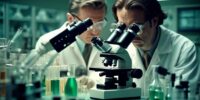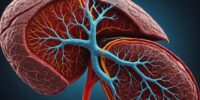First Organ Transplant (1954) – Murray: Recap and Summary: Pioneered Kidney Transplant

Dr. Joseph Murray revolutionized the field of transplant medicine in 1954 by pioneering the first successful kidney transplant. His groundbreaking work has saved countless lives through the practice of organ transplantation.
Key Takeaways
- Organ transplantation began in the early 20th century, with the first successful kidney transplant on a dog in 1902.
- Dr. Joseph Murray revolutionized the field of organ transplantation through his research on allograft transplantation and the development of methods to prevent organ rejection.
- The first successful kidney transplant in 1954, led by Dr. Joseph Murray, opened doors for further advancements and provided new treatment options for patients with end-stage organ failure.
- Advancements in surgical techniques, immunosuppressive therapy, and organ preservation have greatly improved the success rates and outcomes of organ transplantation.
The Origins of Organ Transplantation
The origins of organ transplantation can be traced back to the early 20th century when pioneering surgeons began exploring the possibilities of replacing damaged or failing organs in the human body. The history of organ transplantation is a testament to human perseverance and the desire to extend and improve the quality of life.
The concept of organ transplantation first emerged in the 1900s, with experiments conducted on animals to understand the feasibility of transferring organs between different individuals. In 1902, the first successful kidney transplant was performed on a dog, laying the foundation for future advancements in the field.
However, it wasn't until the mid-20th century that organ transplantation became a reality for humans. In 1954, Dr. Joseph Murray performed the first successful kidney transplant between identical twins, marking a significant milestone in medical history. This breakthrough paved the way for further research and progress in the field of organ transplantation.
Since then, the field of organ transplantation has witnessed remarkable advancements, with organs such as the heart, liver, lungs, and pancreas successfully transplanted to save countless lives. The history of organ transplantation is a testament to the dedication and expertise of medical professionals, as well as the generosity of organ donors and their families. It's a reminder of the power of science and human compassion in overcoming the challenges of organ failure.
Dr. Joseph Murray's Groundbreaking Research
Dr. Joseph Murray's groundbreaking research revolutionized the field of organ transplantation, propelling it forward from its early origins in the 20th century. His work laid the foundation for medical breakthroughs that continue to save countless lives today.
Murray's research focused on the concept of transplanting organs from one individual to another, known as allograft transplantation. He conducted extensive experiments to refine surgical techniques and develop methods to prevent organ rejection. His groundbreaking research led to the first successful kidney transplant in 1954, where he transplanted a kidney between identical twins.
Murray's achievements marked a turning point in medical history. Prior to his research, organ transplantation was considered an impossible feat due to the body's rejection of foreign organs. However, his innovative approaches, such as the use of immunosuppressive drugs, paved the way for further advancements in the field.
Murray's groundbreaking research not only saved the lives of countless patients suffering from kidney failure but also opened the doors to transplanting other organs, such as the heart, liver, and lungs. His work set the stage for the development of organ transplant programs worldwide, offering hope to patients in need and transforming the landscape of modern medicine.
The First Successful Kidney Transplant
In 1954, a milestone in medical history was achieved with the successful transplantation of a kidney between two identical twins. This groundbreaking procedure marked the first successful kidney transplant, paving the way for future advancements in surgical techniques.
The first successful kidney transplant was performed by a team of surgeons led by Dr. Joseph Murray at the Peter Bent Brigham Hospital in Boston. The recipient, Richard Herrick, suffered from end-stage renal disease, a condition that leads to kidney failure. His identical twin brother, Ronald Herrick, volunteered to donate one of his kidneys in an attempt to save his brother's life.
The surgery itself was a complex and delicate procedure. Dr. Murray and his team had to overcome numerous challenges, including the risk of organ rejection and the technical difficulties associated with transplanting such a vital organ. However, their meticulous planning and expertise in surgical techniques allowed them to carry out the successful transplant.
This groundbreaking achievement not only saved Richard Herrick's life but also opened the door to further advancements in kidney transplantation. The success of this first procedure laid the foundation for future research and developments in the field, leading to improved surgical techniques, better organ preservation methods, and the development of immunosuppressive drugs to prevent organ rejection.
Challenges and Risks in Early Transplants
Early organ transplants faced significant challenges and risks due to the limitations of surgical techniques and issues with donor compatibility. Surgeons had to develop innovative methods to successfully transplant organs, often with limited knowledge and experience.
Additionally, ensuring that the donor organ was compatible with the recipient's immune system was a major hurdle that had to be overcome to prevent rejection and increase the chances of a successful transplant.
These challenges and risks played a pivotal role in shaping the field of organ transplantation and paved the way for advancements in surgical techniques and immunosuppressive therapies.
Early Surgical Techniques
In the early days of organ transplantation, there were several challenges and risks associated with the surgical techniques. One of the main challenges was the lack of advanced medical technology and knowledge. Surgeons had to rely on early medical advancements and surgical innovations to perform these complex procedures. The surgical techniques used were often experimental and carried a high risk of complications and failure.
In addition, the lack of effective immunosuppressant drugs made it difficult to prevent the recipient's immune system from rejecting the transplanted organ. This led to a high rate of organ rejection and limited the success of early transplants.
Despite these challenges and risks, early surgeons paved the way for further advancements in organ transplantation, ultimately saving countless lives.
Donor Compatibility Issues
Despite the challenges and risks involved in early surgical techniques, another significant issue in the early days of organ transplantation was the compatibility of donors, posing additional challenges and risks.
Donor selection played a crucial role in the success of organ transplants. Finding a suitable donor was essential to minimize the risk of rejection by the recipient's immune system. However, limited knowledge and understanding of immunology at the time made it difficult to identify compatible donors. This led to higher rates of transplant rejection and failure.
To address this issue, researchers explored immunosuppressive therapy, which involved using drugs to suppress the recipient's immune system and reduce the risk of rejection. Although this approach showed promise, it also came with its own set of risks and complications, including increased vulnerability to infections and other health complications.
Impact and Significance of Murray's Achievement
Murray's achievement in performing the first organ transplant had a profound impact on the field of medicine. This breakthrough paved the way for future advancements in transplantation, allowing for the transfer of organs between individuals.
Medical Breakthroughs in Transplantation
One of the most significant medical breakthroughs in transplantation was the successful completion of the first organ transplant. This milestone achievement, which occurred in 1954, marked a turning point in medical history and paved the way for future advancements in the field of transplantation.
Prior to this groundbreaking procedure, patients suffering from end-stage organ failure had limited treatment options and often faced a bleak prognosis. However, with the successful transplantation of a kidney from one human to another, a new era of medical possibilities emerged.
This breakthrough not only demonstrated the feasibility of organ transplantation but also highlighted the potential for saving countless lives through this innovative medical procedure. The first organ transplant laid the foundation for further developments in transplantation history and continues to impact the lives of patients today.
Improving Patient Survival Rates
The impact and significance of Murray's achievement in improving patient survival rates can't be overstated. His groundbreaking work in organ transplantation revolutionized the medical field and greatly enhanced patient outcomes.
Prior to Murray's pioneering efforts, the success rates of organ transplants were extremely low, with many patients succumbing to rejection or complications. However, Murray's advancements in surgical techniques and immunosuppressive drugs significantly improved transplant success rates.
Revolutionizing Organ Transplantation
Revolutionizing the field of organ transplantation, Dr. Murray's groundbreaking achievements have forever changed the landscape of medical science. His contributions have had a profound impact on medicine, not only in terms of patient survival rates but also in terms of the ethical considerations surrounding organ transplantation.
Here are four key ways in which Dr. Murray's work has revolutionized medicine:
- Advancing surgical techniques: Dr. Murray's pioneering techniques laid the foundation for successful organ transplants, enabling surgeons to perform complex procedures with greater precision and success.
- Expanding the donor pool: By demonstrating that organs could be successfully transplanted from living donors, Dr. Murray expanded the potential donor pool, saving countless lives and reducing the burden on deceased donor organs.
- Transforming the field of immunology: Dr. Murray's work shed light on the body's immune response to transplanted organs, leading to significant advancements in immunosuppressive therapy and reducing the risk of organ rejection.
- Raising ethical considerations: Dr. Murray's achievements sparked important ethical discussions surrounding organ transplantation, including issues of consent, allocation, and the balance between the risks and benefits for both donors and recipients.
Through his groundbreaking work, Dr. Murray's revolutionized medicine and opened up new possibilities for patients in need of life-saving organ transplants.
Advancements in Organ Preservation Techniques
In recent years, significant advancements have been made in the techniques used for preserving organs, leading to improved success rates in organ transplantation. Organ preservation plays a crucial role in ensuring the viability and functionality of organs before transplantation. These advancements have resulted in longer organ storage times and increased transplant success rates.
One notable advancement is the development of machine perfusion techniques. This method involves pumping a preservation solution through the blood vessels of the organ to maintain its oxygen and nutrient supply. Machine perfusion allows for better assessment and monitoring of organ function, reducing the risk of organ damage during preservation.
Another significant innovation is the use of hypothermic preservation techniques. Organs are cooled to temperatures below normal body temperature, slowing down metabolic processes and reducing cellular damage. This technique has extended the preservation time for organs, particularly for kidney transplants.
Advancements in preservation solutions have also contributed to improved organ preservation. These solutions contain a combination of electrolytes, antioxidants, and other additives that help maintain organ function and prevent cellular damage.
Table:
| Advancements in Organ Preservation Techniques |
|---|
| Machine Perfusion |
| Hypothermic Preservation |
| Improved Preservation Solutions |
| Longer Preservation Times |
These advancements have revolutionized organ transplantation by increasing the availability of viable organs and improving patient outcomes. With further research and development, the future holds promising possibilities for organ preservation techniques, paving the way for more successful transplantation procedures.
The Evolution of Organ Transplantation
With the advancements in organ preservation techniques laying a strong foundation, the evolution of organ transplantation has ushered in a new era of medical possibilities. This remarkable journey has witnessed several evolutionary milestones and raised important ethical implications.
Here are four key developments that have shaped the field of organ transplantation:
- Improved surgical techniques: Over time, surgical procedures have become more refined, allowing for safer and more successful organ transplants. Surgeons now have better tools and instruments, as well as enhanced knowledge of anatomy and immunology, leading to improved patient outcomes.
- Development of immunosuppressive drugs: The discovery and development of immunosuppressive drugs have revolutionized organ transplantation. These medications help prevent the recipient's immune system from rejecting the transplanted organ, increasing the chances of a successful transplant.
- Expansion of the donor pool: The evolution of organ transplantation has led to an expansion of the donor pool. In addition to deceased donors, living donors, such as family members or altruistic individuals, can now donate organs, allowing for more transplant opportunities.
- Advancements in organ preservation: The development of better organ preservation techniques, such as cold storage and machine perfusion, has significantly extended the viability of organs, increasing the chances of successful transplantation.
However, along with these significant advancements, organ transplantation also raises ethical implications. Questions regarding organ allocation, consent, and the concept of commodification continue to be debated, highlighting the need for thoughtful consideration and regulation in this evolving field.
Murray's Legacy and the Future of Transplant Medicine
Murray's groundbreaking work in organ transplantation continues to shape the future of transplant medicine. His impact on the field has been profound, paving the way for future advancements in the field of organ transplantation.
Murray's pioneering work in kidney transplantation laid the foundation for the development of new surgical techniques and immunosuppressive drugs. His successful kidney transplant in 1954 opened up new possibilities for patients suffering from end-stage renal disease, giving them a chance at a longer and healthier life.
In addition to his surgical achievements, Murray's legacy also extends to his contributions in the field of ethics. He was a strong advocate for organ donation and transplantation, emphasizing the importance of informed consent and the ethical considerations surrounding the allocation of organs.
Looking to the future, Murray's impact is evident in the ongoing advancements in transplant medicine. Researchers are continually working to improve the success rates of organ transplantation, develop new techniques for preserving organs, and find innovative ways to overcome the challenges of organ rejection.
The future of transplant medicine holds great promise, thanks to Murray's pioneering work and the dedication of researchers and medical professionals worldwide. As technology advances and our understanding of immunology improves, we can expect even more breakthroughs in the field of organ transplantation, ultimately leading to better outcomes for patients in need.
Frequently Asked Questions
How Many Organ Transplants Were Performed Before Dr. Joseph Murray's Groundbreaking Research?
Before Dr. Joseph Murray's groundbreaking research, only a handful of organ transplants were performed. However, his work revolutionized the field, leading to an exponential increase in the number of successful organ transplants worldwide.
How Long Did It Take for Dr. Murray to Develop the Surgical Techniques for the First Successful Kidney Transplant?
It took Dr. Murray several years to develop the surgical techniques for the first successful kidney transplant. His development timeline included numerous surgical innovations that paved the way for future organ transplant surgeries.
What Were Some of the Challenges Faced by Early Transplant Surgeons in Performing Organ Transplants?
You might wonder what challenges early transplant surgeons faced in developing surgical techniques. Well, they had to overcome limited knowledge, rejection issues, and technical difficulties to make organ transplants possible.
Did Dr. Murray Face Any Ethical or Legal Challenges in Conducting the First Kidney Transplant?
Dr. Murray faced ethical challenges in conducting the first kidney transplant, as the procedure was experimental and raised concerns about patient autonomy and consent. He also faced legal challenges due to the lack of established guidelines and regulations for organ transplantation at the time.
What Were the Long-Term Outcomes for the Patient Who Received the First Successful Kidney Transplant?
The long-term outcomes for the patient who received the first successful kidney transplant were positive, leading to significant medical advancements in organ transplantation.








